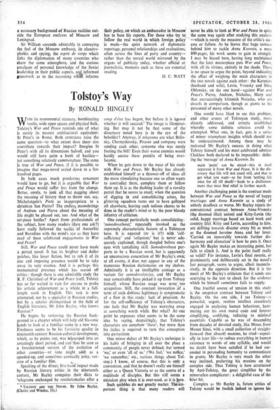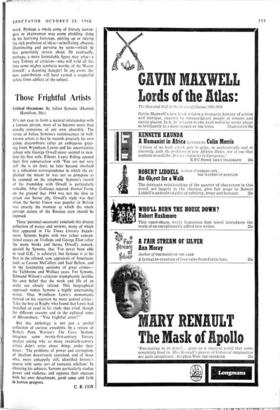Tolstoy's Way
By RONALD HINGLEY
Wait its monumental statuary, bombinating vaults, wide open spaces and-physical bulk, Tolstoy's War and Peace reminds one of what is surely its nearest architectural equivalent: St Peter's in Rome. Both structures raise the same question—to what extent does sheer size contribute towards their impact? Imagine St Peter's with all its dimensions halved, and you would still have quite a hunk of basilica— yet something relatively commonplace. The same is true of War and Peace, if it is possible to imagine that mega-novel scaled down to a few hundred pages.
In both cases much ponderous ornament would have to go, but it is arguable that War and Peace would suffer less from The change. Better, surely, to junk all that oagging about the meaning of history than to- throw out, say, Michelangelo's Pieta as inappropriate to a shrunken San Pietro? The endlesk maunderings of Andrew and Pierre about the meaning of life might be phased out, too. And what of the set-piece battles? Apart from professionals of the subject, how many readers (dare one ask?) have really followed the tactics -of Austerlitz and Borodino with the mind's eye as they have read of these celebrated engagements in War and Peace?
Still, War and Peace could never have made a potted novel. It has its brighter and duller patches, like lesser fiction, but to rob it of its size and imposing presence would be to take away its very essence. And it is perhaps this monumental presence which has scared off critics: though there is one admirable study (by R. F. Christian) of War and Peace itself, Tolstoy has so far waited in vain for anyone to probe his artistic achievement as a whole in a full- length work in English. This task is now attempted, not by a specialist in Russian studies, but by a scholar distinguished in the field of English literature, Mr John Bayley, who knows Russian.* He begins by reviewing the Russian back- ground in a chapter which will help old Slavonic hands to look at a familiar scene in a new way. Freshness seems to be his favourite quality in nineteenth-century Russian cultural development, which, as he points out, was telescoped into an amazingly short period, and can thus be seen as a foreshortened version of the evolution of other countries—or (one might add) as a speeded-up, and sometimes comically jerky, ver- sion of a familiar film. 4*- Speaking of the direct, first-hand impact made by Russian literary critics in the nineteenth century, Mr Bayley compaies their dicta to `telegrams exchanged by revolutionaries after a * Totsrox AND THE Novo.. By John Bayley. (Chatto and Windus, 35s.) coup d'etat has begun, but before it is ligownI whether it will succeed.' The image is illuminat- ing. But may it not be that some of the directness- noted here is in the eye of the beholder? Anyway, if telegrams are what Belin- sky, Chernyshevsky, Pisarev and company were sending each other, someone else was surely footing the bill! Even their worse enemies would hardly accuse these pundits of being over– laconic.
When he gets down to the meat of his study with War and Peace, Mr Bayley has already established himself as a thrower-off of ideas all the more stimulating because one so often wants to contradict them, complete them or follow them up. It is as the dashing leader of a cavalry patrol that he seems to excel; when the question of digging in and consolidating arises, the glittering squadron turns out to have galloped off elsewhere, leaving such tedious chores to be done in the reader's mind or by the poor bloody' infantry of criticism.
One concept particularly needs consolidating: `samodovolnost,' repeatedly invoked as the supremely characteristic feature of a Tolitoyan hero. It is equated (or is it?) with 'self- sufficiency' and 'solipsism,' but is never ade- quately explained, though dangled before one's eyes with tantalising skill. Samodovolnost pur- ports to be a Russian word, but is apparently an unconscious concoction of Mr Bayley's own; at all events, it does not appear in any of the numerous Russian dictionaries on my shelves. Admittedly it is an intelligible coinage as a variant for samodovolstviye, and Mr Bayley may conceivably have picked it up from Tolstoy himself, whose Russian usage was none too scrupulous. Still, the constant invocation ,of a term of such dubious legitimacy is symptomatic of a flaw in this study: lack of precision. As for the self-sufficiency of Tolstoy's characters, one feels that Mr Bayley was worrying away at something worth while. But what? At one point he expresses what seems to be the same idea by saying, despairingly, that Tolstoy's characters are somehow `there'; but more than his italics is required to turn this conception into parturition.
One minor defect of Mr Bayley's technique is his habit of bringing in all over the place a community of people never defined, but termed `we,' or even 'all of us.' ('We feel,' we `we remember,' etc., various things about Tol- stoy.) I know, of course, that this is only a convention, and that he doesn't really see himself either as a Queen Victoria or as the centre of a multitude of disciples. But this still seems a mistaken ploy when it is over-used, as it is re.
Such quibbles-do not greatly matter.
portant thing is that many readers will never be able to look at War and Peace in quite the same way again after studying this analysis —which is surely the measure of the critic's suc- cess or failure. As he leaves that huge carcase behind him to tackle Anna Karenin, a mere 800-pager, his work seems to gain in strength. I may be biased here, having long maintained that the later masterpiece puts War and Peace, with all its virtues, entirely in the shade. There is no space to argue the point, beyond indicating the effect of weighing the main characters in the two novels against each other: the Karenins (husband and wife), Levin, Vronsky and Stiva Oblonsky, on the one hand—against War and Peace's Pierre, Andrew, Nicholas, .Mary and that excruciatingly kittenish Natasha, who are dwarfs in comparison, though as giants to the personnel of many other novels.
One would have liked to see this problem, and other cruces of Tolstoyan study, more directly addressed, and criteria established whereby some definite solution could be attempted. What one, in fact, gets is a series of minor triumphant insights which should not be underestimated. Among these may be reckoned Mr Bayley's success in doing what Tolstoy himself and his most celebrated admirer Chekhov both declared to be impossible : defin- ing the `message' of Anna Karenin. Its main `point' can be stated—this in itself separates it from War and Peace. It is the dis- covery that life will not stand still, and that to get what you want—so far from 'settling life once for all till death'—leads to a disillusion- ment that must find relief in further search.
Another challenging point is the contrast made between War and Peace as the novel of happy marriages and Anna Karenin as a study of unholy deadlock or worse. Mr Bayley rejects the conventional contrast between Anna-Vronsky (the doomed illicit union) and Kitty-Levin (the solid, happy marriage based on, hard work and country life). Kitty and Levin, according to him, are drifting towards disaster every bit as much as the doomed heroine Anna and her lover. `Carried on inexorably towards further dis- harmony and alienation' is how he puts it. Once again Mr Bayley makes an interesting point, but fails to clinch it. And is the point itself really so valid? For instance, Levin's final reverie, so prominently and deliberately set in the novel's last paragraph,.seems to argue, albeit inconclu- sively, in the opposite direction. But it is the merit of Mr Bayley's criticism that it sends one scurrying to the text to check for the evidence which he himself sometimes fails to supply.
One fruitful source of tension in this study is the unspoken contrast between Tolstoy and Bayley. On the one side, I see Tolstoy—a powerful, urgent, restless intellect ceaselessly engaged in analysing human behaViour, ham- mering out his own -moral code and forever simplifying, codifying, reducing to minimal essentials. Capable as he was of descending from decades of devoted study, like Moses from Mount Sinai, with a small collection of straight- forward (but absurd) maxims, he tried—especi- ally in later life—to reduce everything in human _ existence to words of one syllable, and would no doubt have been satisfied if he had suc- ceeded in persuading humanity to communicate in grunts. Mr Bayley is very much the other way inclined, preferring his maxims on the complex side. Thus Tolstoy is here scrutinised by Anti-Tolstoy, the great simplifier by the remorseless complicater: a delightful case of the biter bit.
Complex as Mr Bayley is, future critics of Tolstoy would be foolish indeed to ignore his work. Perhaps a whole army of literary scaven- gers or charwomen may come plodding along in his hurrying footsteps. picking up or tidying the rich profusion of ideas—scintillating, obscure, illuminating and perverse by turns—which he has generously strewn about. Or eventually, perhaps, a more formidable figure may arise—a very Tolstoy of criticism—who will weld all this into some mighty synthesis worthy of the Master himself : a daunting thought! In any event, this new contribution will have earned a respectful salute from addicts of the subject.







































 Previous page
Previous page